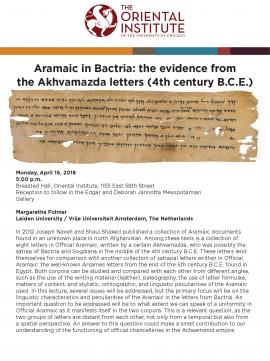"Aramaic in Bactria: The Evidence from the Akhvamazda Letters (4th Century B.C.E.)"
Margaretha Folmer
Leiden University / Vrije Universiteit Amsterdam, The Netherlands
Monday
April 16, 2018
5:00 p.m.
Breasted Hall of the Oriental Institute
In 2012 Joseph Naveh and Shaul Shaked published a collection of Aramaic documents found in an unknown place in north Afghanistan. Among these texts is a collection of eight letters in Official Aramaic, written by a certain Akhvamazda, who was possibly the satrap of Bactria and Sogdiana in the middle of the 4th century B.C.E. These letters lend themselves for comparison with another collection of satrapal letters written in Official Aramaic: the well-known Arsames letters from the end of the 5th century B.C.E. found in Egypt. Both corpora can be studied and compared with each other from different angles, such as the use of the writing material (leather), paleography, the use of letter formulae, matters of content, and stylistic, orthographic, and linguistic peculiarities of the Aramaic used. In this lecture, several issues will be addressed, but the primary focus will be on the linguistic characteristics and peculiarities of the Aramaic in the letters from Bactria. An important question to be addressed will be to what extent we can speak of a uniformity in Official Aramaic as it manifests itself in the two corpora. This is a relevant question, as the two groups of letters are distant from each other, not only from a temporal but also from a spatial perspective. An answer to this question could make a small contribution to our understanding of the functioning of official chancelleries in the Achaemenid empire.


